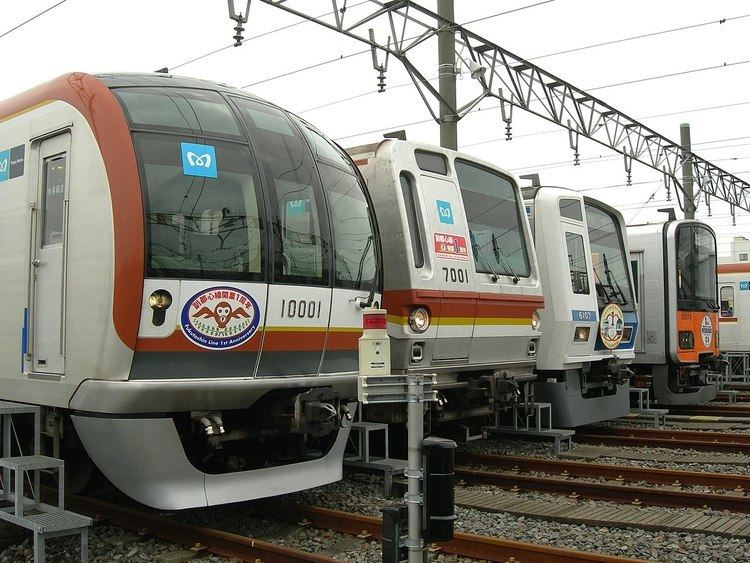Other name(s) No. 13 Fukutoshin Line Termini WakōshiShibuya | Native name 東京地下鉄副都心線 Stations 16 | |
 | ||
The Tokyo Metro Fukutoshin Line (東京地下鉄副都心線, Tōkyō Chikatetsu Fukutoshin-sen), formally the No. 13 Fukutoshin Line (13号線(副都心線), Jūsangō-sen (Fukutoshin-sen)), is a subway line operated by the Tokyo subway operator Tokyo Metro in west-central Tokyo, Japan. The newest line in the Tokyo subway network, it opened in stages between 1994 and 2008.
Contents
Overview
The Fukutoshin Line is the deepest metro line in Tokyo, with an average depth of 27 meters. At Shinjuku-sanchōme Station, the line passes under the Marunouchi and above the Shinjuku lines at a depth of 15 meters, with a gap of only 11 centimeters to the Shinjuku Line tunnel. The deepest section is at the immediately adjacent Higashi-Shinjuku Station, where the line goes down to 35 meters, partly due to an underground space reservation for a possible future extension of the Jōetsu Shinkansen to Shinjuku.
It is the second Tokyo Metro line to feature express services, after the Tōzai Line; however, unlike the Tozai Line (where rapid services are only offered on the Tōyōchō – Nishi-Funabashi section), the Fukutoshin Line offers express services throughout the line, a first for Tokyo Metro. Express trains pass local trains at Higashi-Shinjuku, where additional tracks are installed for this purpose. Local trains stop at all stations.
When first opened, the line operated through services to Kawagoeshi Station on the Tobu Tojo Line and Hannō Station on the Seibu Ikebukuro Line. From 16 March 2013, the Tōkyū Tōyoko Line moved to share the line's Shibuya terminus, and since then through services have operated onto the Minatomirai Line via the Tōyoko Line, terminating at Motomachi-Chūkagai Station in Yokohama. This is a rare instance of a Tokyo Metro train operating on four companies' tracks.
Between Kotake-Mukaihara Station and Shibuya Station the Fukutoshin Line operates as a one-man operation subway line where chest-high platform edge doors are installed on the station platforms to aid the drivers.
Like most Tokyo Metro lines, the first carriage of the Fukutoshin Line is designated a "women only car" before and during the morning rush hour. During these hours only women, children of elementary school age or younger and physically disabled passengers (and their carers) may board the first carriage.
Station list
Tokyo Metro
Other operators
History
Fukutoshin is Japanese for "secondary city center", and the Fukutoshin Line connects three of Tokyo's secondary city centers: Ikebukuro, Shinjuku and Shibuya. Prior to its opening, only JR East had rail service between the three (on the Yamanote Line, the Saikyō Line and the Shōnan-Shinjuku Line). The new line was conceived to relieve congestion along this busy corridor, and to provide convenient through service between the northwest, the southwest and the central part of Tokyo served by the Yamanote Line.
The line was initially planned in 1972 as a run from Shiki, Saitama to Shinjuku, with the possibility of further extension to Shibuya, Shinagawa and Haneda Airport. In 1985, a second Ministry of Transportation committee proposed that the line terminate at Shibuya. Part of the northern end of the original plan line became unnecessary following improvements to the Tobu Tojo Line and the beginning of through service from the Yurakucho Line.
The original plan for the Fukutoshin Line only contained fifteen stations, however in May 1999 a plan for an additional station "Shin-Sendagaya" (later renamed Kitasandō) between Shinjuku-Sanchōme and Meiji-Jingūmae was included due to an increase in demand from the area.
A 3.2 km segment from Kotake-Mukaihara to Ikebukuro, running parallel to the Yurakucho Line on separate tracks began operation in 1994. This segment was initially known as the Yūrakuchō New Line (有楽町新線, Yūrakuchō Shin-sen), and was operated with no intermediate stops.
The newest segment connecting the districts of Shinjuku and Shibuya via Zōshigaya, Sendagaya and Harajuku opened for service on 14 June 2008, officially completing the Fukutoshin Line. Service to the Senkawa and Kanamechō stations, which had been bypassed by the Yūrakuchō New Line, also started on the same day. Technical problems resulted in delays of up to 30 minutes during the Fukutoshin Line's first few days of operation.
On 6 March 2010, express services began stopping at Meiji-Jingūmae Station on weekends and holidays.
From 10 September 2012, 10-car 5050-4000 series sets entered revenue service on the Tokyo Metro Fukutoshin Line, with inter-running through to the Seibu Ikebukuro Line (via Seibu Yurakucho Line) and Tobu Tojo Line.
